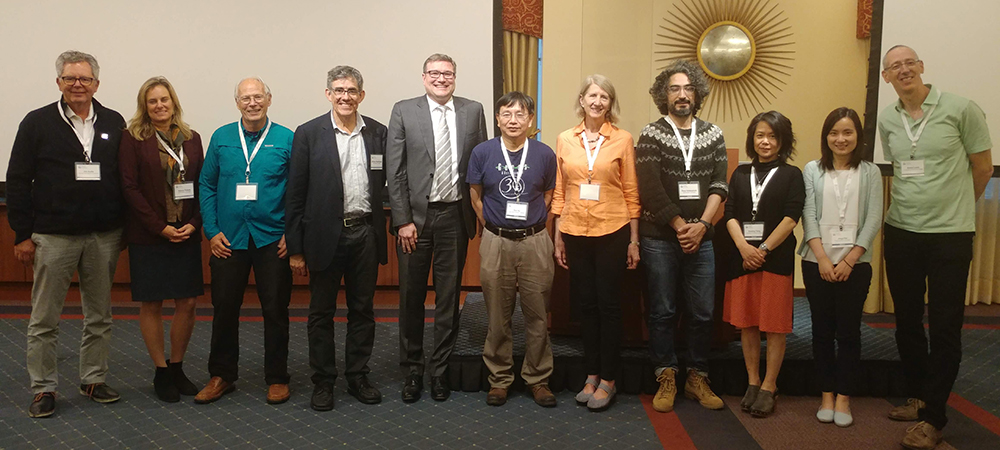October 10, 2018
Cutting Edge Discoveries and Technologies in Structural Biology
16th Annual CBC Symposium – a recap

16th Annual CBC Symposium. From the left: CBC Executive Director Jim Audia, Valerie Tokars (NU), Tony Kossiakoff (UChicago), Alfonso Mondragón (NU), André Hoelz (Caltech), Eric Xu (Van Andel Research Institute), Janet Smith (University of Michigan), Reza Vafabakhsh (NU), Xiaojing Yang (UIC), Jingyi Fei (UChicago) and Arnon Lavie (UIC).
The Chicago Biomedical Consortium (CBC) held its 16th Annual Symposium, A New Age of Structural Biology: Structure meets Dynamics, on Wednesday, November 3, 2018. The event was organized by Northwestern’s Alfonso Mondragón, and a committee of faculty members from all three CBC universities which included Valerie Tokars (NU), Anthony Kossiakoff (UChicago), and Arnon Lavie (UIC). The all-day symposium was held at the Feinberg Conference Center in NU Memorial Hospital. Over 180 scientists attended this outstanding meeting which included an interactive poster session, 6 outstanding cutting-edge scientific presentation, a Data Blitz highlighting 6 posters presented by graduate students and post-docs from the CBC universities, and a networking reception at the conclusion of the event.
The impressive scientific program included 6 talks focusing on the biology of cellular structures and the structural and computational technologies used to understand the mechanisms by which structure is converted to function. Jingyi Fei (UChicago) described her approach to studying the binding kinetics of tRNA recognition of T-box Riboswitch at the single-molecule lever. She described her novel single-molecule fluorescence techniques to study the series of functional steps involved in recognition and binding of one RNA molecule to another RNA molecule and the conformational charges in the RNA molecules. University of Michigan’s Janet Smith’s presentation focused on the family of cytidine deaminases, APOBEC3H (A3H), and how A3H recognizes HIV. Following HIV infection, A3H enters viral particles and binds to strands of RNA in the viral genome. The RNA is copied into DNA, and before it inserts into the human genome, A3H mutates it. Using a crystal of A3H with bound RNA, her lab was able to show that A3H formed a dimer around the short RNA duplex in areas predicted to contain duplexes, and retained potent cytidine deaminase activity.
The afternoon session began with Northwestern’s Reza Vafabakhsh presenting his research on information processing at the plasma membrane and how membrane proteins process information and convert chemical signals into conformational changes. The Vafabakhsh lab employs a number of structural techniques, including single-molecule FRET to map conformational changes in complex systems. Eric Xu from the Van Andel Research Institute shared his insight into the structural biology of GPCR signaling complexes. Xu’s lab took advantage of the simplest GPCR, the bacterial rhodopsin system, as a model for more complex systems with regard to G-protein coupling mechanisms. André Hoelz from Caltech gave an exciting talk on the structural biology of the human nuclear pore complex, (NPC) one of largest proteinaceous assemblies in eukaryotic cells. His research employs X-ray crystallography, electron microscopy, and biochemistry to understand the structural features of the NPC necessary for the selective transport of complexes across the nuclear envelop, its role in gene regulation, and how changes in NPC components are linked to several human diseases. UIC’s Xiaojing Yang concluded the afternoon program with an overview of her research on how proteins convert chemical signals into molecular responses. Focus is on understanding the function of specific signaling proteins and photoreceptors at atomic resolution. To achieve these goals, her lab is developing dynamic crystallography by transforming cryo-EM from an imaging technique to a dynamic approach.
Enjoy the photos from the event!
Photos: Corinna Kitcharoen, CBC
See more:
▸ Symposium webpage
▸ Symposium program
▸ Symposium speakers’ bios
▸ Symposium flyer
